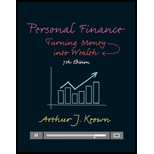
Case summary:
Mr. C is 31 years old and Mrs. T is 30 years old. They have a son Mr. C and a daughter Ms. H. Mr. C is a store manager and makes $45,000 a year, while Mrs. T is an accountant who earns $53,000 each year. The D family is currently renting a townhome for $2,000 per month but they are hoping to put a down payment on their dream home within 3 to 5 years. Currently they have $13,000 saved in mutual fund with the intention to put it towards their down payment. Mrs. T has a life insurance policy that has built up a cash value of $1,800. Their credit card debt typically remains around $1,300 while they make $100 monthly payments. Together they have a saving account balance of $2,500. Mrs. on the other hand, indicated that she is willing to take financial risks when she thinks the returns are worthwhile. Both Mr. C and Mrs. T enjoy the outdoors and maintain their health. They have even considered joining a golf club that charges a monthly fee of $250. They have two automobiles one of which they own and they still owe $12,925 on the other. Their household furniture, electronics, and other personal property are worth approximately $12,000. One of their greatest assets however is Mrs. T’s antique jewelry, which she received from her grandmother. The jewelry is valued at $19,700. Mrs. T also has a mutual fund that was given to her by her father. The current value of the fund is $2,300. Combines, they have a student loan balance of $8,200 and an installment loan with a balance of $5,300.
Character in this case:
Mr. C, Mrs. T, Ms H and Mr. Ch.
Adequate information:
Food (at home and dining out) $6,900
Medical insurance $3,200
Renter’s insurance $600
Charity donations $2,400
Property taxes (auto) $695
Savings $1,200
To construct:
Income statement for the given family.
Introduction:
Income statement refers to that statement which contains the net period income or loss of an individual or a company. It also contains the expenses for the given period.
Want to see the full answer?
Check out a sample textbook solution
Chapter 4 Solutions
Personal Finance: Turning Money into Wealth (7th Edition) (Prentice Hall Series in Finance)
- Describe in detail what exactly is the Cash Conversion Cycle, how is it computed and what is the purpose of this calculation (how is it used).arrow_forwardExplain what Interest Rate Parity is, how it is calculated, and why it is important to a company operating internationally.arrow_forwardCompare and contrast the three core means of adding shareholder wealth; Cash Dividends, Stock Dividends and Stock Splits, and Stock Repurchases. Include the various advantages and disadvantages of each one.arrow_forward
- Calculate the future value of a lump sum of $1,000 invested for 4 years at 10%, using compounded quarterly.arrow_forwardIf value is not clear then please comment i will write values dont solve question, i will give unhelpful.arrow_forwardwhat are some of the question can i asek my prinsiple of finance teache?arrow_forward
- A critical discussion of the hockey stick model of start-up financing should be presented, supported by recent in-text citations. Provide a detailed explanation of the model. Describe each of the three stages of the hockey stick model of start-up financing, including a detailed characterisation of each stage. The characterisation of each stage should detail the growth, risk, and funding expectations. Present a critical evaluation and an insightful conclu sion.arrow_forwardQuestion Workspace Check My Work New-Project Analysis The president of your company, MorChuck Enterprises, has asked you to evaluate the proposed acquisition of a new chromatograph for the firm's R&D department. The equipment's basic price is $64,000, and it would cost another $18,000 to modify it for special use by your firm. The chromatograph, which falls into the MACRS 3-year class, would be sold after 3 years for $28,400. The MACRS rates for the first three years are 0.3333, 0.4445 and 0.1481. (Ignore the half-year convention for the straight-line method.) Use of the equipment would require an increase in net working capital (spare parts inventory) of $3,000. The machine would have no effect on revenues, but it is expected to save the firm $24,760 per year in before-tax operating costs, mainly labor. The firm's marginal federal-plus-state tax rate is 25%. Cash outflows and negative NPV value, if any, should be indicated by a minus sign. Do not round intermediate…arrow_forwardAlthough the Chen Company's milling machine is old, it is still in relatively good working order and would last for another 10 years. It is inefficient compared to modern standards, though, and so the company is considering replacing it. The new milling machine, at a cost of $108,000 delivered and installed, would also last for 10 years and would produce after-tax cash flows (labor savings and depreciation tax savings) of $19,000 per year. It would have zero salvage value at the end of its life. The project cost of capital is 11%, and its marginal tax rate is 25%. Should Chen buy the new machine? Do not round intermediate calculations. Round your answer to the nearest cent. Negative value, if any, should be indicated by a minus sign.arrow_forward
 Essentials Of InvestmentsFinanceISBN:9781260013924Author:Bodie, Zvi, Kane, Alex, MARCUS, Alan J.Publisher:Mcgraw-hill Education,
Essentials Of InvestmentsFinanceISBN:9781260013924Author:Bodie, Zvi, Kane, Alex, MARCUS, Alan J.Publisher:Mcgraw-hill Education,

 Foundations Of FinanceFinanceISBN:9780134897264Author:KEOWN, Arthur J., Martin, John D., PETTY, J. WilliamPublisher:Pearson,
Foundations Of FinanceFinanceISBN:9780134897264Author:KEOWN, Arthur J., Martin, John D., PETTY, J. WilliamPublisher:Pearson, Fundamentals of Financial Management (MindTap Cou...FinanceISBN:9781337395250Author:Eugene F. Brigham, Joel F. HoustonPublisher:Cengage Learning
Fundamentals of Financial Management (MindTap Cou...FinanceISBN:9781337395250Author:Eugene F. Brigham, Joel F. HoustonPublisher:Cengage Learning Corporate Finance (The Mcgraw-hill/Irwin Series i...FinanceISBN:9780077861759Author:Stephen A. Ross Franco Modigliani Professor of Financial Economics Professor, Randolph W Westerfield Robert R. Dockson Deans Chair in Bus. Admin., Jeffrey Jaffe, Bradford D Jordan ProfessorPublisher:McGraw-Hill Education
Corporate Finance (The Mcgraw-hill/Irwin Series i...FinanceISBN:9780077861759Author:Stephen A. Ross Franco Modigliani Professor of Financial Economics Professor, Randolph W Westerfield Robert R. Dockson Deans Chair in Bus. Admin., Jeffrey Jaffe, Bradford D Jordan ProfessorPublisher:McGraw-Hill Education





